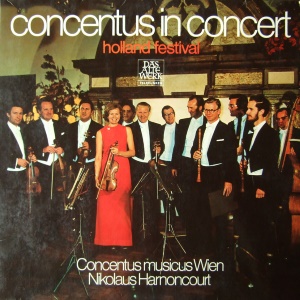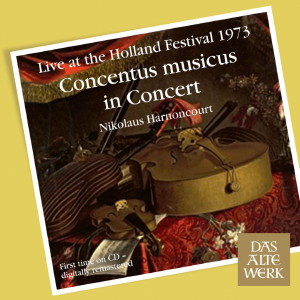 |
1 LP -
SAW 9626-M - (p) 1974
|
 |
| 1 CD -
2564 66211-9 - (c) 2012 |
|
concentus in concert -
holland festival
|
|
|
|
|
|
|
|
| Antonio Vivaldi
(1678-1741) |
|
|
|
| Concerto B-dur op.10,2 "La
Notte" P. 342 |
|
8' 35" |
A1 |
- Largo
|
1' 14" |
|
|
| - Fantasmi: Presto - Largo -
Andante |
3' 03" |
|
|
| - Il Sonno: Largo |
1' 39" |
|
|
| - Allegro |
2' 42" |
|
|
|
|
|
|
| Georg Friedrich Händel
(1685-1759) |
|
|
|
Concerto Nr. 3 (1) g-moll für
Oboe, Streicher und B.c., Hwv 287
|
|
8' 45" |
A2 |
- Grave
|
2' 32" |
|
|
| - Allegro |
1' 56" |
|
|
| - Sarabande: Largo |
2' 13" |
|
|
| - Allegro |
2' 06" |
|
|
|
|
|
|
| Marin Marais (1656-1728) |
|
|
|
Suite aus "Alcyone"
|
|
17' 30" |
B |
| - 1er Air: Gravement et
piqué |
2' 07" |
|
|
| - 2ème Air: Sarabande |
2' 14" |
|
|
| - Gigue |
1' 22" |
|
|
| - Menuet |
1' 40" |
|
|
| - Air des Matelots I et II |
0' 45" |
|
|
| - Air des Matelots:
Tambourin |
0' 38" |
|
|
| - Chaconne |
7' 10" |
|
|
| - Tambourin I et II |
1' 42" |
|
|
|
|
|
|
| Concentus
Musicus Wien |
|
| Nikolaus
Harnoncourt, Leitung |
|
|
Luogo
e data di registrazione
|
| Lutherse Kerk,
Den Haag (Olanda) - 26 giugno 1973 |
|
Registrazione
live / studio
|
| live |
Producer
/ Engineer
|
-
|
Prima Edizione CD
|
Teldec
"Das Alte Werk" - 2564 66211-9 - (1 cd)
- 73' 37" - (c) 2012 - ADD
|
|
Prima
Edizione LP
|
Telefunken "Das
Alte Werk" - SAW 9626-M
- (1 lp) - 34'
50"
- (p) 1974
|
|
|
Notes
|
When in 1953 the
twenty-flve-year-old celllst Nikolaus
Harnoncourt, together with some of his
colleagues from the Vienna Symphony
Orchestra, formed an ensemble
specialising in early music played on
period instruments, no-one dreamt that
a new era of authentic musical sound
was opening up. After a four-year
pcriod of preparation, Harnoncourt
gave an initial concert, which was
followed by annual cycles and tours
abroad. In 1963 the Brandenburg
Concertos were introduced into the
programme. But it was the gramophone
recording that played a decisive role
in communicating this new concept of
what early music sounded like, and in
particular its
interpretation in conformity with
historical performance practice. The
medium's success could be measured by
the increased following for this
freshly revived performance practice.
The Concentus musicns Wien now
effectively became a recording
ensemble.
The fact that, besides meeting
ever-growing recording demands, the
members of the Concentus musicus Wren
continued to play on modern
instruments for opera and concert
performances at first prevented the
ensemble from establishing itself
fully on the concert circuit. In 1968
Harnoncourt became more heavily
involved than before in the concert
series of different cities. in spite
of reservations about the lack of
suitable halls. For Harnoncourt, the
extraordinary success of this
enterprise was proof that the effects
of launching a career primarily with
recordings were surprisengly
far-reaching, and that music-lovers
were just as keen to experience the
ensemble in the concert hall in a live
performance as on record.
There is one very good reason for
this: at these concerts the listener
discovers that the Concentus musicus
ensemble is not just a touched-up
product of the recording studios where
any sub-stadard passages are re-done,
or inaccurate intonation from the
rather temperamental period wind
instruments smoothed out, but one that
more than confidently holds its own in
the traditional concert world - it
shines there. It is not, therefore,
merely a sterile reconstruction of an
archaic concept of sound. Instead we
receive the direct impact of a lively
performance by present-day musicians
of vitality and temperament in which
they convey a concept of musical sound
that we have been able to reproduce
from historical models - albeit with
the feelings of a musician of today.
The popularity of the Concentus
musicus on the public concert platform
also goes to prove that this group has
succeded in avoiding that academic air
otherwise associated with the esoteric
specialist. Not only has it got away
from the mechanical srape-scrape
jocularity of traditional "baroque"
music-making, but it also knows how to
keep free from mannerism, from the
evils of an artificially reconstructed
art, a manipulated appropriation of
music from the past. It goes without
saying that only highly qualified
musicians could ever attempt this
confrontation - i. e. modern
instrumentalists vis-a-vis the musical
ideals of sound of a bygone era. They
show - on the concert platform clearly
and indisputably - just how thrilling
their playing can be, how lucidly
Harnoncourt, not from the conductor's
rostrum but from the 'cellist's desk,
can demonstrate the music of
yesterday, freed from the false
conventions of the nineteenth century.
Free too from any hint of mass
production in respect of style and
timbre, free from puristic bias and
academic blinkers, always flexible in
respect of the uniqueness of an actual
performance - at a public concert so
refreshing and at the same time
illuminating, and at a studio
recording session allowing the
livelines to be pressed into the
grooves with the music. And this is a
true of their Monteverdi as of their
Mozart, to name but two corner-stones
of the Concentus musicus repertoire.
Monteverdi's music, a crucial part of
Harnoncourt's work, is given in
addition to its authentic "soynd
picture" a performing style, as a
result of Harnoncourt's serupulous
research, translated for us so that
the "language" of the "talking"
intervals and musical devices becomes
intelligible and meaningful even to
the modern listener with no knowledge
of the ancient principles of musical
rhetoric. And this so direct and
convincingly that public performances
like that of Monteverdi's opera "The
Return of Odysseus" at the Vienna
Festival could turn out to be as much
a success with the audience as any
popular Verdi opera. Mozart is
likewise treated to a more authentic
interpretation than stereotyped
concert life usually affords it: truer
in respect of tonal balance and
colour, of phrasing, and, in
particular, of its Mozartian rhythms,
which, freely breathing and
improvisational, combine with the
melodic accent.
At a live concert performance the
listener is made to realize that the
members of the Concentus musicus
regard the irretrievability of each
moment, the fact that there is no
chance to repeat a passage, as
something positive, which makes for a
much more intense awareness of the
other partners and of the hall itself.
----------
In
baroque times music was much more an
immediate, intelligible “language”
than we can conceive of today. The
“musical speech“ or formulas of
communication followed certain rules
known, at least, to the musicians.
Everything was governed by a distinct
musical rhetoric embracing details
such as characteristic motifs of
intervals. We have only to think of
the association of moods with modes
and keys for a very marked example, or
the "oratorical“, in the double sense
of the term, or what Mattheson called
"Klangrede" (musical speech). Today,
we approach this music from a more or
less purely aesthetic aspect, without
really “understanding” the language.
Significantly, too, it is realized to
a much greater extent in the music of
J. S. Bach than, in say, that of
Vivaldi that certain musical "signs"
possess concrete meanings or
extra-musical associations exactly
“translatable". And this despite the
latter’s frequent use of such sound
patterns. In Vivaldi’s music we find,
rather, a direct conversion into
musical language of impressions from
Nature, or character traits - a kind
of programme music, of which the
French were very fond too. As,
however, the term “programme music“ in
its nineteenth century connotation has
become somewhat suspect to us, it
needs to be employed here with
caution.
"La Notte“ for example, Vivaldi used
as a title for two compositions, once
for a flute concerto and then for a
bassoon concerto. The flute concerto
contains headings with exact
specifications. Vivaldi, however,
appears rather to model his music on
the idea than to copy it - although
one could not go so far as to use the
term "Empfindung" for it in the sense
one uses it with Beethoven. The first
movement of Opus 10 No. 2 in G minor
is entitled "Fantasmi", but conjures
up troubled thoughts rather than
actual phantoms: scales are wound
together canonically or in thirds,
syncopations and rapid semiquavers
convey a mood of unrest. A calming
flute melody is contrasted with
triplets on the bassoon. The second
movement, "ll Sonno", does not produce
an altogether peaceful "sleep" either:
subtle chromaticism, freely
interpolated suspensions and
dissonances which remain unresolved
over long stretches offer a sharp
contrast to the gentle close: the
night wins through. the dreams vanish.
The influence of the ltalian style on
Handel's work right up to the last
should not be underestimated, any more
than should the effect of Handel's own
personal style on his early "Italian"
compositions. Thus in the Oboe
Concerto in G minor we find both the
concertante principles of ltalian
baroque and the sweeping
improvisational element, the robust
musicality of Handel himself,
represented with equal conviction.
With Handel's music we have not only a
"language" but the charm of an
individual "accent" too.
Marais, a fine bass-viol player, was,
after his teacher Lully, the most
famous of the French baroque
musicians. He was probably the first
composer to try to produce natural
effects with musical media. It is said
that, in order to find novel effects
for a storm scene in his crpera
"Alcyone", written for the Parisian in
1706, he made a special journey to the
coast. Thus, what in appearance is a
conventional suite is, in fact, also a
depiction of natural phenomena, such
as we can find being constantly tried
out in the music of the succeeding
centuries.
W. E. v.
Lewinski (1973)
Translation: Avril Watts
|
|
Nikolaus
Harnoncourt (1929-2016)
|

|

|
|